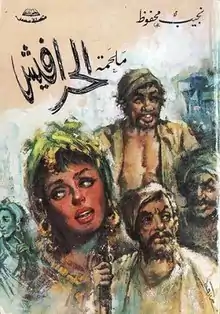The Harafish
The Harafish (Arabic: الحرافيش) (in orig. Arabic Malhamat al-harafish) is a 1977 novel written by Naguib Mahfouz. It comprises a series of episodes in a dozen generations of a family from the Egyptian urban rabble (the "harafish"). Many of the members of this family become clan chiefs in an alley in the city; some of them are benefactors to the other members of the harafish; some are more corrupt. Neither the location within Egypt nor the time of the events is ever identified.
 Early Arabic edition | |
| Author | Naguib Mahfouz |
|---|---|
| Original title | ملحمة الحرافيش |
| Translator | Catherine Cobham |
| Country | Egypt |
| Language | Arabic |
| Genre | Novel |
| Publisher | Maktabat Misr (1977 arabic) Doubleday (Eng. trans.) |
Publication date | 1977 |
Published in English | April 1994 |
| Media type | Print (Paperback) |
| ISBN | 0-385-42324-1 (Eng. trans.) |
| OCLC | 27894526 |
| 892/.736 20 | |
| LC Class | PJ7846.A46 M2813 1994 |
Although location and timing are never specified, inferences can be made to narrow the range. Reference to location is made several times in The Harafish (English translation). When Ashur and Fulla flee the plague-infested alley, they reside in the caves of the foothills. Ashur leaves the cave "to take water from the public drinking fountain in Darasa" (p. 39). Darasa is located east of present-day Cairo, between the foothills and the Nile river. Further reference to the Nile occurs on page 356: "Strange rumours came from outside the alley. The Nile was not going to flood that year." Egypt has suffered numerous outbreaks of plague. The 13th-century Bubonic Plague is thought to have originated in Egypt, timing coincidental with the writings of the 13th-century Sufi Persian poet Rumi.[1]
References
- "Egypt: Cairo: Islamic Monuments- The Baybars El-Jashankir Khanqa". Tour Egypt. Retrieved 2019-04-18.
The Baybars El-Jashankir Khanqa is the oldest Sufi monastery in Cairo, established around 1310 by Baybars el-Jashankir